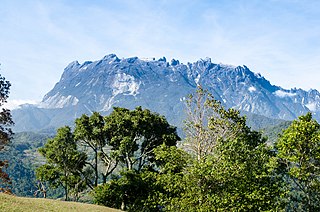
Mount Kinabalu is the highest mountain in Borneo and Malaysia. With an elevation of 13,435 feet (4,095 m), it is third-highest peak of an island on Earth, and 20th most prominent mountain in the world by topographic prominence. The mountain is located in Ranau district, West Coast Division of Sabah, Malaysia. It is protected as Kinabalu Park, a World Heritage Site.

Nepenthes rajah is a carnivorous pitcher plant species of the family Nepenthaceae. It is endemic to Mount Kinabalu and neighbouring Mount Tambuyukon in Sabah, Malaysian Borneo. Nepenthes rajah grows exclusively on serpentine substrates, particularly in areas of seeping ground water where the soil is loose and permanently moist. The species has an altitudinal range of 1,500–2,650 metres (4,920–8,690 ft) a.s.l. and is thus considered a highland or sub-alpine plant. Due to its localised distribution, N. rajah is classified as an endangered species by the IUCN and listed on CITES Appendix I.

Mount Tambuyukon or Tamboyukon is a mountain located at the West Coast Division of Sabah, Malaysia. It is considered the third-highest mountain in the country with height at 2,579 metres (8,461 ft), lying north of the highest Mount Kinabalu.

Nepenthes villosa, or the villose pitcher-plant, is a tropical pitcher plant endemic to Mount Kinabalu and neighbouring Mount Tambuyukon in northeastern Borneo. It grows at higher elevations than any other Bornean Nepenthes species, occurring at elevations of over 3,200 m (10,500 ft). Nepenthes villosa is characterised by its highly developed and intricate peristome, which distinguishes it from the closely related N. edwardsiana and N. macrophylla.
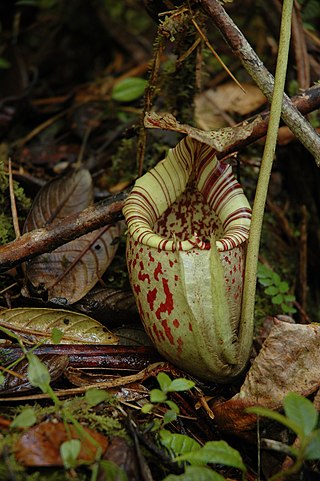
Nepenthes burbidgeae, also known as the painted pitcher plant or Burbidge's Pitcher-Plant, is a tropical pitcher plant with a patchy distribution around Mount Kinabalu and neighbouring Mount Tambuyukon in Sabah, Borneo.

Nepenthes tentaculata, or the fringed pitcher-plant, is a tropical pitcher plant with a wide distribution across Borneo and Sulawesi. It grows at altitudes of 400–2550 m.

Nepenthes × kinabaluensis, or the Kinabalu pitcher-plant, is the natural hybrid between N. rajah and N. villosa. It was first collected near Kambarangoh on Mount Kinabalu, Borneo by Lilian Gibbs in 1910 and later mentioned by John Muirhead Macfarlane as "Nepenthes sp." in 1914. Although Macfarlane did not formally name the plant, he noted that "[a]ll available morphological details suggest that this is a hybrid between N. villosa and N. rajah". It was finally described in 1976 by Shigeo Kurata as N. × kinabaluensis. The name was first published in Nepenthes of Mount Kinabalu, but was a nomen nudum at the time as it lacked an adequate description and information on the type specimen. The name was subsequently published validly by Kurata in 1984.
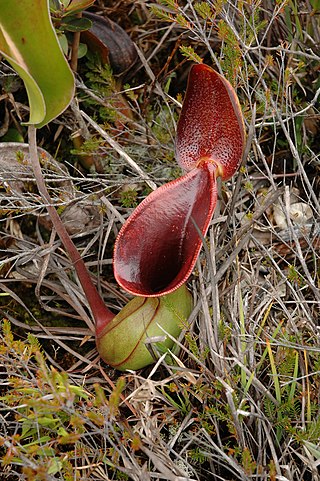
Nepenthes lowii, or Low's pitcher-plant, is a tropical pitcher plant endemic to Borneo. It is named after Hugh Low, who discovered it on Mount Kinabalu. This species is perhaps the most unusual in the genus, being characterised by its strongly constricted upper pitchers, which bear a greatly reduced peristome and a reflexed lid with numerous bristles on its lower surface.
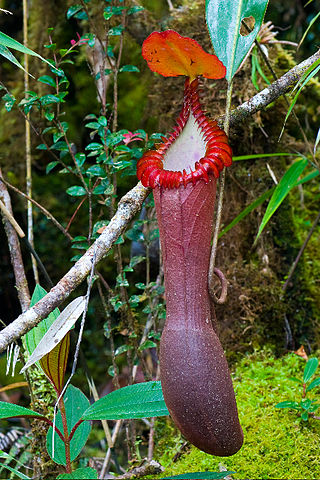
Nepenthes edwardsiana, or the splendid pitcher-plant, is a carnivorous tropical pitcher plant endemic to Mount Kinabalu and neighbouring Mount Tambuyukon in Sabah, Malaysian Borneo. It is considered one of the most spectacular of all Nepenthes, producing some of the largest pitchers and the most highly developed peristome ribs of any species in the genus.

Nepenthes fusca, or the dusky pitcher-plant, is a tropical pitcher plant endemic to Borneo. It is found throughout a wide altitudinal range and is almost always epiphytic in nature, primarily growing in mossy forest.
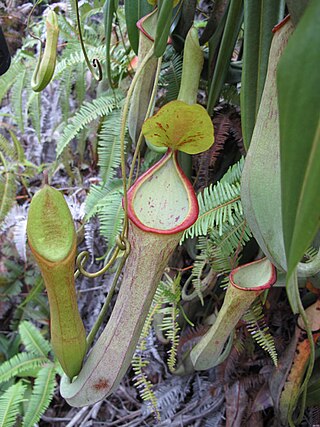
Nepenthes macrovulgaris, or the serpentine pitcher-plant, is a tropical pitcher plant endemic to Borneo. It is a lowland plant that typically grows at altitudes ranging from 300 to 1200 m in sub-montane forest clearings and mossy forest. Its range is restricted to ultramafic habitats, including Mount Kinabalu, Mount Tambuyukon, the Danum Valley, the Tawai Range, the Meliau Range and Mount Silam, all in Sabah, Malaysian Borneo. Pitchers grow to around 25 cm high and range in colour from green to brown, with the speckled form being the most common.

Nepenthes stenophylla, or the narrow-leaved pitcher-plant, is a tropical pitcher plant endemic to Borneo. The species produces attractive funnel-shaped pitchers up to 25 cm high. It is listed as Least Concern on the IUCN Red List. Nepenthes stenophylla belongs to the loosely defined "N. maxima complex", which also includes, among other species, N. boschiana, N. chaniana, N. epiphytica, N. eymae, N. faizaliana, N. fusca, N. klossii, N. maxima, N. platychila, and N. vogelii.

Nepenthes macrophylla, the large-leaved pitcher-plant, is a tropical pitcher plant known only from a very restrictive elevation on Mount Trusmadi in Sabah, Malaysian Borneo.
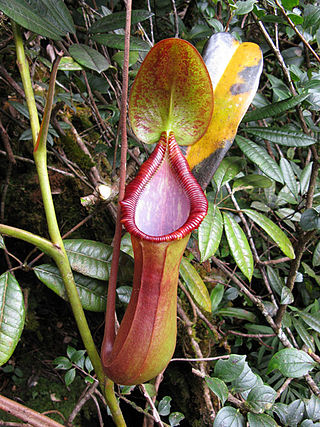
Nepenthes × trusmadiensis, or the Trus Madi Pitcher-Plant, is a natural hybrid of two famous Bornean pitcher plant species: N. lowii and N. macrophylla. It is restricted to Mount Trus Madi, where both of its parent species are sympatric.

The black-footed shrew is a species of mammal in the family Soricidae. It is endemic to northern and central Sulawesi, Indonesia where it lives on the floor of the tropical forests. The International Union for Conservation of Nature has assessed its conservation status as being of "least concern".

The Kinabalu shrew is a species in the family Soricidae. It is endemic to the mountain Mount Kinabalu on Borneo, and its sister peak, Mount Tambuyukon.

Nepenthes of Mount Kinabalu is a monograph by Shigeo Kurata on the tropical pitcher plants of Mount Kinabalu and the surrounding area of Kinabalu National Park in Sabah, Borneo. It was published in 1976 by Sabah National Parks Trustees as the second booklet of the Sabah National Parks series. The monograph is Kurata's most important work on Nepenthes and significantly contributed to popular interest in these plants. It is noted for its high quality colour photographs of plants in habitat. In the book's preface, Kurata writes:
While Nepenthes were often enumerated as an important component of the flora of this mountain, a book on this genus—relating exclusively to Kinabalu had never been published to this date. With such a situation and the interest shown by visitors to the Kinabalu National Park in the genus, Mr. D.V. Jenkins, Assistant Director, Sabah National Parks was prompted to publish a guide book on the species found within the park and I was delighted to be asked to write the text.

The Bornean shrew is a species of mammal in the family Soricidae. It is found only on Borneo, throughout most of the island; it may or may not be present in Brunei.

The peninsular shrew is a species of mammal in the family Soricidae. It is found in the Malay Peninsula and Thailand. It is also found on the adjacent islands of Koh Samui, Pulau Tioman, and Pulau Mapor. This species has recently been synonymized with Crocidura malayana




















